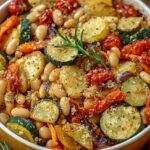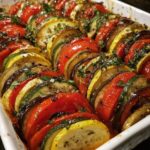Rustic Roasted Vegetable Bake with Cannellini Beans: A Cozy, Wholesome Meal
Imagine pulling a sizzling dish from the oven, filled with caramelized vegetables and creamy beans, filling your kitchen with an irresistible aroma. This Rustic Roasted Vegetable Bake with Cannellini Beans recipe delivers exactly that experience. It is a celebration of simple, wholesome ingredients transformed into a deeply satisfying meal. Furthermore, it is the perfect answer for busy weeknights when you crave something nourishing yet effortless.
The magic of this dish lies in the roasting process. High heat coaxes out the natural sugars in the vegetables, creating sweet, tender bites with beautifully crisp edges. Simultaneously, the cannellini beans become wonderfully creamy, soaking up the herb-infused olive oil. This Rustic Roasted Vegetable Bake with Cannellini Beans is not just a meal; it is a warm, comforting hug in a bowl. It proves that healthy eating can be incredibly delicious and deeply satisfying.
Ultimately, this one-pan wonder is designed for real life. It requires minimal prep and cleanup, making it a go-to for hectic schedules. Whether you are a seasoned cook or just starting out, this recipe guides you to a perfect result every time. Gather your favorite root vegetables and get ready to create a family-friendly dish that will become a regular on your dinner rotation.
Quick Recipe Highlights
- Flavor Profile: This bake offers a symphony of savory, sweet, and earthy notes. The roasted vegetables develop a deep caramelization, while herbs like rosemary and thyme add a fragrant, woody aroma. Additionally, a hint of garlic ties all the flavors together beautifully.
- Texture: You will experience a delightful contrast in every bite. The vegetables become tender yet retain a slight bite, while the cannellini beans offer a creamy, velvety texture that complements the crispier edges of the roast.
- Aroma: As it bakes, your kitchen will fill with the warm, inviting scents of roasting garlic and earthy herbs. This aroma is unmistakably comforting and promises a wholesome, home-cooked meal that everyone will love.
- Visual Appeal: The bake is a vibrant medley of colors, from the deep orange of sweet potatoes to the green of zucchini and red of bell peppers. It is a visually stunning dish that looks as good as it tastes, perfect for serving directly at the table.
- Skill Level Needed: This recipe is perfect for beginners. It involves simple chopping and tossing, with no complicated techniques required. Essentially, if you can use a knife and an oven, you can master this rustic roasted vegetable dish.
- Special Equipment: You only need a large baking sheet or a ceramic baking dish. A good chef’s knife for prepping the vegetables is helpful, but otherwise, no special tools are necessary for this easy vegetable bake.
Recipe Overview
- Difficulty Level: We classify this recipe as easy because it involves straightforward techniques like chopping and roasting. There is no fussy timing or complex steps; you simply combine the ingredients and let the oven do the work. Consequently, it is an excellent choice for cooking novices or anyone seeking a stress-free meal.
- Category: This dish fits perfectly into several meal categories. It works wonderfully as a hearty main course for a vegetarian dinner, a substantial side dish alongside roasted chicken or fish, or even as a premium meal prep option for lunches throughout the week.
- Cuisine: This recipe draws inspiration from the broad and sun-drenched traditions of Mediterranean cuisine. It emphasizes fresh vegetables, beans, and olive oil, hallmarks of a healthy and flavorful eating style. The rustic preparation is reminiscent of family-style dishes found throughout Southern Europe.
- Cost: This is an incredibly budget-friendly meal. Root vegetables and canned beans are typically inexpensive, especially when in season. Making this rustic roasted vegetable bake is a cost-effective way to feed a family a nutritious and satisfying meal without straining your grocery budget.
- Season: While truly a year-round dish, this bake shines in the fall and winter. It makes use of sturdy, seasonal vegetables like sweet potatoes and red onion that are at their peak. The warm, oven-roasted result is particularly comforting on cooler evenings.
- Occasion: This versatile dish is suitable for any occasion. It is a simple weeknight dinner, a casual potluck contribution, or a cozy component of a weekend feast. Its crowd-pleasing nature and easy preparation make it incredibly adaptable.
Why You’ll Love This Recipe
First and foremost, the taste and texture of this Rustic Roasted Vegetable Bake with Cannellini Beans are utterly irresistible. The high-heat roasting process caramelizes the natural sugars in the vegetables, creating a wonderful sweetness that contrasts with their savory, earthy depth. Meanwhile, the cannellini beans become soft and creamy, providing a velvety base that soaks up all the herby, garlic-infused olive oil. Every forkful is a perfect balance of tender, crisp, and creamy elements, making it a truly satisfying eating experience that will have you coming back for seconds.
From a convenience standpoint, this recipe is a lifesaver. It requires just 15 minutes of active prep time; you simply chop, toss, and spread everything on a pan. After that, the oven takes over, freeing you up to relax or prepare other components of your meal. Moreover, it is a one-pan wonder, meaning cleanup is an absolute breeze. This Rustic Roasted Vegetable Bake with Cannellini Beans is the ultimate solution for a busy weeknight when you want a healthy, home-cooked dinner without the hassle and mess of multiple pots and pans.
Nutritionally, this dish is a powerhouse. It is packed with vitamins, minerals, and fiber from the diverse array of vegetables. The cannellini beans contribute a significant amount of plant-based protein and complex carbohydrates, making this bake incredibly filling and sustaining. It is a meal that nourishes your body from the inside out, supporting digestion, energy levels, and overall well-being. You can feel great about serving this to your family, knowing you are providing a balanced and wholesome meal.
This Rustic Roasted Vegetable Bake with Cannellini Beans also holds tremendous social and entertaining value. Its vibrant, colorful presentation is naturally impressive, making it perfect for serving guests at a casual dinner party. It is a fantastic vegetarian centerpiece that can easily be doubled to feed a crowd. The rustic, family-style nature of the dish encourages sharing and conversation, creating a warm and inviting atmosphere around the dinner table.
Finally, the cost-effectiveness and accessibility of this recipe cannot be overstated. The ingredients are humble, affordable, and easy to find at any standard grocery store. You can also adapt it based on what is on sale or in season, making it a versatile staple for any budget. This Rustic Roasted Vegetable Bake with Cannellini Beans demonstrates that eating well does not require expensive or exotic ingredients, just a little bit of know-how and a hot oven.
Historical Background and Cultural Significance
The concept of roasting vegetables alongside beans is deeply rooted in peasant cooking traditions across Europe and the Mediterranean. For centuries, home cooks relied on the hearth or oven to transform humble, readily available ingredients into nourishing meals. This Rustic Roasted Vegetable Bake with Cannellini Beans is a modern incarnation of that timeless practice. It embodies the “cucina povera” philosophy of Italian cooking, which celebrates creating extraordinary food from simple, poor ingredients through technique and respect for the components.
Culturally, dishes like this serve as a centerpiece for family gatherings and community meals in many regions. In countries like Italy, Greece, and Spain, a large tray of roasted vegetables often appears on the table, shared among everyone. The inclusion of cannellini beans, a staple in Tuscan cuisine especially, adds a protein-rich element that makes the dish a complete meal. This practice of sharing a communal dish fosters a sense of togetherness and celebration of the harvest’s bounty.
The recipe has evolved significantly with the globalization of food and the modern home kitchen. While our ancestors used whatever root vegetables were stored for winter, today’s version often includes a colorful mix like zucchini and bell peppers, available year-round. The specific combination in this Rustic Roasted Vegetable Bake with Cannellini Beans is a contemporary take, designed for maximum flavor, color, and nutrition, reflecting our current access to a wider variety of produce and a greater emphasis on plant-based eating.
Regional variations of this concept are endless. In Provence, you might find a similar bake with ratatouille vegetables and herbes de Provence. In the American South, black-eyed peas and okra could be roasted with spices like paprika. Our version with cannellini beans, rosemary, and garlic leans into its Tuscan influences. This adaptability is key to the dish’s enduring appeal, allowing it to be reimagined with local flavors and ingredients across the world.
Ingredient Deep Dive
Sweet Potatoes: Sweet potatoes have a rich history, originating in Central or South America over 5,000 years ago. They were a staple crop for ancient civilizations and were later carried across the globe by explorers. Nutritionally, they are a superstar, packed with beta-carotene (which converts to Vitamin A), fiber, and complex carbohydrates. When selecting, look for firm potatoes with smooth, taut skin. Avoid any with soft spots or signs of sprouting. Store them in a cool, dark, well-ventilated place—not the refrigerator. For a variation, you can substitute with regular potatoes, carrots, or even winter squash like butternut.
Cannellini Beans: Also known as white kidney beans, cannellini beans are a cornerstone of Italian cuisine, particularly from the Tuscany region, where they are used in soups like ribollita and salads. They are an excellent source of plant-based protein, fiber, iron, and folate. Their creamy texture and mild, nutty flavor make them incredibly versatile. For this recipe, canned beans are perfectly convenient; just be sure to rinse them well to remove excess sodium. If you prefer dried beans, remember to soak and cook them beforehand. Great substitutes include Great Northern beans or navy beans.
Zucchini: Zucchini, a type of summer squash, is native to the Americas but was developed into its modern form in Italy. It is a low-calorie vegetable that provides vitamin C, manganese, and a high water content, making it hydrating and gentle on the digestion. Choose small to medium-sized zucchini that feel heavy for their size and have bright, glossy skin. Larger zucchinis can be seedy and watery. Store them in the refrigerator’s crisper drawer. Yellow squash is a perfect substitute, offering a nearly identical texture and flavor profile.
Red Onion: Red onions have been cultivated for thousands of years and are prized for their milder, sweeter flavor compared to yellow or white onions, especially when roasted. They contain quercetin, a powerful antioxidant, and organosulfur compounds that have anti-inflammatory properties. Select onions that are firm with dry, papery skins and avoid any that are soft or have a pungent smell. Store them in a cool, dark, dry place. If you do not have red onion, a sweet yellow onion like a Vidalia is the best alternative.
Common Mistakes to Avoid
- Overcrowding the Pan: This is the most common error. If the vegetables are piled on top of each other, they will steam instead of roast. Consequently, you will miss out on the desirable caramelized, crispy edges. Always use a large enough baking sheet to give the pieces plenty of space.
- Uneven Chopping: Cutting your vegetables into vastly different sizes leads to uneven cooking. Some pieces will be burnt while others remain hard. Aim for a uniform, bite-sized chop so everything finishes roasting at the same time for a perfect texture.
- Skimping on Oil: Olive oil is crucial for conducting heat and promoting browning. Using too little will result in dry, steamed vegetables rather than golden-brown and tender ones. Ensure each piece has a light, glossy coating before it goes into the oven.
- Using a Cold Pan/Oven: Always preheat your oven thoroughly. Adding the bake to a cold oven drastically changes the cooking time and texture. A hot oven is essential for that initial sear that locks in flavor and creates a crisp exterior.
- Not Seasoning Enough: Vegetables and beans need ample seasoning to shine. Do not be shy with the salt and pepper. Season at the tossing stage so the flavors penetrate the ingredients throughout the cooking process, not just sit on the surface.
- Stirring Too Frequently: Resist the urge to stir the bake constantly. Let it sit undisturbed for at least 20-25 minutes to allow the vegetables to develop a proper roasted, caramelized crust. Constant stirring will prevent this from happening.
- Adding Delicate Herbs Too Early: If you are using fresh, soft herbs like basil or parsley, add them after baking. Adding them at the beginning will cause them to burn and become bitter. Woody herbs like rosemary and thyme can handle the heat.
- Forgetting to Rinse Canned Beans: The liquid in canned beans is often starchy and high in sodium. Always drain and rinse your cannellini beans thoroughly. This step prevents the final dish from being gloppy or overly salty.
Essential Techniques
Uniform Chopping: Mastering uniform chopping is the first step to a perfectly cooked bake. Consistent size ensures that every piece of vegetable cooks at the same rate, preventing a mix of undercooked and burnt bits. To do this, first cut your vegetables into halves or quarters to create flat, stable surfaces. Then, proceed to dice them into similarly sized cubes or chunks. A common pitfall is rushing this step, leading to irregular pieces. The visual cue for success is a baking sheet filled with pieces that all look roughly the same size, promising even roasting.
The High-Heat Roast: Roasting at a high temperature, typically between 400°F and 425°F (200°C-220°C), is non-negotiable. This technique is vital because it quickly caramelizes the natural sugars on the surface of the vegetables, creating a deep, complex flavor and a delightfully crisp texture. The goal is to achieve browning without burning the interior. A common mistake is roasting at too low a temperature, which steams the vegetables instead. You will know you have mastered it when the edges of the vegetables are browned and slightly crisp, while a fork easily pierces the center.
Tossing with Oil and Seasonings: This is about more than just mixing; it is about coating and infusing. Thoroughly tossing the vegetables and beans in oil ensures that every surface is lightly coated, which promotes even browning and prevents drying out. Equally important, this is the stage where you evenly distribute salt, pepper, and herbs. A common pitfall is adding seasonings after roasting, which does not allow the flavors to meld. The visual cue for success is a glossy, even sheen on all the ingredients before they even hit the hot pan.
Pro Tips for Perfect Rustic Roasted Vegetable Bake
- For extra crispy edges, place the baking sheet in the oven while it preheats. Adding the vegetables to a hot pan gives them an immediate sear, kickstarting the caramelization process and resulting in a superior texture.
- Do not discard any leftover fresh herbs. Instead, chop them finely and mix them into a small bowl of olive oil. Drizzle this herb-infused oil over the bake just before serving for a burst of fresh flavor and aroma.
- If you have time, spread the chopped vegetables on a clean kitchen towel and pat them dry before tossing with oil. Removing excess surface moisture helps them roast instead of steam, leading to a much crispier final result.
- Add a splash of acidity at the end. A squeeze of fresh lemon juice or a drizzle of balsamic glaze over the finished bake just before serving can brighten all the flavors and cut through the richness beautifully.
- For a flavor boost, toss a few whole, unpeeled garlic cloves with the vegetables. As they roast, they become sweet, soft, and spreadable. You can squeeze the roasted garlic out of its skin and mix it into the bake before serving.
- Let the bake rest for 5 minutes after pulling it from the oven. This allows the ingredients to settle and the intense heat to dissipate slightly, making the flavors more cohesive and the dish easier to serve.
Variations and Adaptations
Regional Variations: You can easily take this bake on a world tour by changing the spice profile. For a Moroccan twist, toss the vegetables with cumin, coriander, and a pinch of cinnamon. For an Italian feel, use oregano and basil alongside the rosemary. To evoke the American Southwest, add chili powder, smoked paprika, and a can of diced green chiles to the mix. Each variation creates a completely different dish while maintaining the same simple preparation method.
Seasonal Adaptations: This recipe is a fantastic canvas for whatever is fresh. In spring, use asparagus, new potatoes, and fresh peas. Summer calls for eggplant, cherry tomatoes, and yellow squash. For a deep winter version, swap in hardy vegetables like parsnips, turnips, and chunks of dense squash like kabocha. Using seasonal produce ensures the best flavor and often a lower cost.
Dietary Modifications: This dish is naturally vegetarian and gluten-free. To make it vegan, ensure you are using a plant-based parmesan alternative or simply omit the cheese—it is still delicious. For a higher-protein version, add a cup of cooked quinoa or lentils to the mix before roasting. If you are watching your carbs, reduce the sweet potato and increase the volume of lower-carb vegetables like zucchini and bell peppers.
Serving and Presentation Guide
Plating Techniques: For a family-style meal, serve the Rustic Roasted Vegetable Bake with Cannellini Beans directly from the baking dish at the table for a rustic, inviting feel. For individual plating, use a shallow bowl and create a small well in the center where you can add a dollop of pesto or a drizzle of high-quality olive oil. Alternatively, use a ring mold to create a neat, vertical stack of the bake in the center of the plate for a more refined presentation.
Garnishing Ideas: A garnish adds a final touch of freshness and color. A sprinkle of chopped fresh parsley, basil, or chives works wonderfully. For texture, add a handful of toasted pine nuts, walnuts, or pumpkin seeds. A final dusting of Parmesan cheese or vegan alternative adds a salty, umami kick. A few microgreens or arugula leaves scattered on top can introduce a peppery note and a beautiful green contrast.
Traditional Accompaniments: This bake is a complete meal on its own, but it pairs beautifully with other dishes. Serve it alongside a simple green salad with a lemony vinaigrette to balance the richness. A slice of crusty, warm bread is perfect for soaking up any delicious juices left on the plate. For a non-vegetarian option, it makes an excellent side dish for roasted chicken, grilled sausages, or baked fish.
Wine and Beverage Pairing
Wine Pairings: The earthy, savory notes of this bake call for wines with good acidity and minimal oak. A crisp Italian white like Pinot Grigio or Vermentino complements the herbs and vegetables without overpowering them. Alternatively, a light-bodied red with low tannins, such as a Gamay (Beaujolais) or a Pinot Noir, can work beautifully, especially if the dish has deeper, caramelized flavors. The key is to choose a wine that refreshes the palate between bites.
Non-Alcoholic Alternatives: For a sophisticated non-alcoholic pairing, try a sparkling water with a squeeze of lemon and a sprig of rosemary. Iced herbal tea, like a mint or lemon verbena tea, is another excellent choice. For something richer, a tomato-based gazpacho-style drink or a non-alcoholic bitter aperitif can mirror the earthy and savory notes of the bake in a refreshing way.
Storage and Shelf Life
Store any leftovers in an airtight container in the refrigerator for up to 4 days. The texture of the vegetables will soften upon storage, but the flavors will continue to meld and develop. For reheating, spread the desired portion in a single layer on a baking sheet and warm it in a 350°F (175°C) oven for about 10-15 minutes until heated through. This method helps restore some of the crispness. Alternatively, you can reheat it in a skillet over medium heat. Avoid microwaving, as it will make the vegetables mushy. This bake can also be frozen for up to 3 months, though the zucchini may become a bit watery upon thawing.
Make Ahead Strategies
This Rustic Roasted Vegetable Bake with Cannellini Beans is an excellent candidate for make-ahead meal prep. You can chop all the vegetables 1-2 days in advance. Store them in separate airtight containers or a large zip-top bag in the refrigerator. The beans can be drained and rinsed ahead of time as well. When you are ready to cook, simply toss the pre-prepped ingredients with oil and seasonings, then roast. You can also fully assemble and bake the dish, then store it in the fridge. Reheat portions as needed throughout the week for quick, healthy lunches or dinners.
Scaling Instructions
This recipe scales up or down very easily. To halve the recipe, simply use half of all the ingredients and bake on a smaller sheet pan. The cook time may be slightly reduced, so start checking for doneness around the 30-minute mark. To double or triple the recipe for a crowd, use two large baking sheets. It is crucial not to overcrowd the pans, so you will need the extra surface area. You may need to rotate the pans halfway through cooking and extend the cooking time by 5-10 minutes to ensure everything gets properly roasted and caramelized.
Nutritional Deep Dive
This Rustic Roasted Vegetable Bake with Cannellini Beans is a nutritional powerhouse. It provides a balanced mix of complex carbohydrates from the sweet potatoes and beans, which offer sustained energy release. The cannellini beans are an excellent source of plant-based protein and dietary fiber, promoting satiety and supporting digestive health. The colorful array of vegetables delivers a wide spectrum of vitamins and antioxidants; sweet potatoes are rich in Vitamin A, bell peppers are packed with Vitamin C, and zucchini contributes potassium. Using olive oil as the primary fat source adds heart-healthy monounsaturated fats. This combination makes the dish an ideal choice for supporting overall wellness, weight management, and a balanced diet.
Dietary Adaptations
Gluten-Free: This recipe is naturally gluten-free, as it relies on whole vegetables, beans, and herbs. Just ensure that any pre-shredded cheese or added sauces are certified gluten-free if you are highly sensitive.
Dairy-Free/Vegan: To make this dish vegan and dairy-free, simply omit the Parmesan cheese garnish. The bake is incredibly flavorful and satisfying without it. For a cheesy flavor, you can sprinkle it with nutritional yeast after baking.
Low-Carb/Keto: For a lower-carb version, eliminate the sweet potato and increase the portions of zucchini and bell peppers. You could also add low-carb vegetables like cauliflower florets and broccoli. The cannellini beans are higher in carbs, so reduce the quantity or omit them.
Low-FODMAP: For a Low-FODMAP adaptation, replace the red onion with the green tops of spring onions (scallions). Omit the garlic and use a garlic-infused olive oil instead, which captures the flavor without the high-FODMAP compounds. Ensure the cannellini beans are well-rinned and limit the portion size, or substitute with canned chickpeas, which are lower in FODMAPs in a 1/4 cup serving.
Troubleshooting Guide
Vegetables Are Soggy: If your bake turns out soft and steamed instead of roasted, the most likely cause is overcrowding the pan. The vegetables release moisture as they cook, and if there is no space for it to evaporate, they will steam. Solution: Always use a large enough baking sheet and spread the ingredients in a single layer. Next time, also ensure your vegetables are thoroughly dry before tossing them in oil.
Vegetables Are Burning: If the edges are charring before the centers are tender, your oven temperature may be too high, or your vegetable pieces may be too small. Solution: Check your oven temperature with an independent thermometer for accuracy. If the temperature is correct, simply chop your vegetables into slightly larger, more uniform pieces next time to ensure they cook through without burning.
Lack of Flavor: If the final dish tastes bland, it is almost always due to underseasoning. Vegetables need a generous amount of salt to bring out their natural flavors. Solution: Before serving, taste and adjust the seasoning. Add more salt and pepper as needed. A splash of acidity, like lemon juice or vinegar, can also brighten and enhance the overall flavor profile dramatically.
Recipe Success Stories
Our community of home cooks has embraced this Rustic Roasted Vegetable Bake with Cannellini Beans with incredible enthusiasm. One reader, Sarah from Colorado, shared that it has become her family’s “Meatless Monday” staple, and her kids now request it by name. Another home cook, Mark, reported adding spicy Italian sausage for his non-vegetarian friends and said it was a huge hit at his potluck. Many have also found success with adaptations; a reader named Lisa used butternut squash and kale with great results, proving the recipe’s wonderful flexibility. Their collective tip for photography? Natural light is your best friend—capture the bake straight from the oven while it is still steaming for the most appetizing shot.
Frequently Asked Questions
Can I use different beans? Absolutely. Great Northern beans, navy beans, or even chickpeas would work wonderfully in this recipe. Chickpeas will hold their shape well and offer a slightly nuttier flavor, making them a great alternative to cannellini beans.
How do I know when the bake is done? The bake is ready when the vegetables are tender enough to be easily pierced with a fork and have developed golden-brown, caramelized edges. The sweet potatoes are usually the best indicator; if they are soft, the other vegetables are likely done as well.
Can I make this in an air fryer? Yes, you can. Cook the vegetables in batches in your air fryer basket at 375°F (190°C) for about 15-20 minutes, shaking the basket halfway through. Be careful not to overcrowd the basket to ensure they get crispy.
Is it freezer-friendly? You can freeze it, but be aware that the texture of the zucchini may become a bit softer and more watery upon thawing and reheating. It will still taste good, but the texture will be less firm.
What can I use instead of rosemary? If you are not a fan of rosemary, dried oregano, thyme, or an Italian seasoning blend are all excellent substitutes. For a different profile, try a teaspoon of smoked paprika.
My vegetables are not browning. What went wrong? This usually happens if the oven temperature is too low, the pan is overcrowded, or the vegetables were too wet when they went in. Ensure your oven is fully preheated, use a large pan, and pat the vegetables dry for best results.
Can I add other vegetables? Definitely. This recipe is very adaptable. Broccoli florets, cauliflower, cherry tomatoes, or sliced mushrooms would all be delicious additions. Just keep an eye on the cooking time, as softer vegetables like tomatoes may cook faster.
Do I need to peel the sweet potatoes? It is not necessary. The skins of sweet potatoes are edible and contain extra fiber and nutrients. Just give them a good scrub before chopping. Leaving the skin on also adds to the rustic texture of the dish.
Additional Resources
If you loved this Rustic Roasted Vegetable Bake with Cannellini Beans, you might enjoy exploring other hearty plant-based dishes on our blog. We have a comprehensive guide to roasting any vegetable perfectly, which can help you customize this bake with your favorites. For those interested in the nutritional benefits of beans, check out our deep dive into different bean varieties and their health impacts. If you are building your kitchen toolkit, we also have a review of our favorite rimmed baking sheets that are perfect for achieving that ideal, all-over crispiness in roasted dishes.
{“success”:true,”message”:”Recipe created successfully”,”post_id”:6618,”tasty_recipe_id”:6618,”shortcode”:” Print
Rustic Roasted Vegetable Bake with Cannellini Beans
5 Stars 4 Stars 3 Stars 2 Stars 1 Star
No reviews
- Author: Chef Billy
Description
A hearty and wholesome vegetable bake featuring roasted seasonal vegetables and creamy cannellini beans, perfect for a comforting meal.
Ingredients
For the Crust:
- 2 cups diced butternut squash
- 1 large red onion, sliced
- 2 bell peppers, chopped
- 1 zucchini, sliced
- 2 cups cherry tomatoes
- 3 cloves garlic, minced
- 2 tablespoons olive oil
- 1 teaspoon dried oregano
- 1 teaspoon smoked paprika
- Salt and black pepper to taste
- 1 (15-ounce) can cannellini beans, drained and rinsed
- 1/4 cup grated Parmesan cheese
- 2 tablespoons chopped fresh parsley
Instructions
1. Prepare the Crust:
- Preheat oven to 400°F (200°C).
- In a large bowl, toss butternut squash, red onion, bell peppers, zucchini, cherry tomatoes, and garlic with olive oil, oregano, paprika, salt, and pepper.
- Spread vegetables evenly on a baking sheet and roast for 25-30 minutes, until tender and lightly browned.
- Stir in cannellini beans and sprinkle with Parmesan cheese. Return to oven for 5 minutes to warm through.
- Garnish with fresh parsley before serving.
Notes
You can customize the seasonings to taste.
I’m Billy, a classically trained culinary school graduate from The Culinary Institute of America with over 12 years in the restaurant industry and over 19 years of cooking experience.







